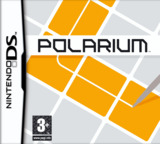Polarium whips up an interesting and engaging puzzle formula, but the bare-bones presentation keeps the game grounded.
The basic concept of Polarium is simple: change the polarity of different black or white tiles on a rectangular plane to make horizontal rows of one solid colour, after which the tiles will disappear. By drawing a line over the tiles using the DS’ stylus, the only method of control present, said tiles flip over revealing whichever colour (of the two available) was not there before. Multiple rows can be flipped at the same time, and mastering various techniques to effectively play the game is both frustrating and rewarding, given the game’s challenge. This foundational gameplay is utilised differently in the game’s three modes, all of which offer a decidedly altered experience from one another.
Challenge Mode is essentially Tetris using Polarium's gameplay. Tiles drop in rows, often several at a time from the top screen, and using the touch screen you have to create horizontal rows of either black or white tiles. Rows can be as large or as small as desired, spanning both vertically and horizontally. It’s a race against time, though there is no time limit; if you aren’t quick enough both screens will fill with tiles: game over. And believe-you-me, this mode is unforgiving. Based on your score you receive a letter ranking, similar to those given in elementary school, and even getting a paltry C is an immense challenge. This mode seems somewhat tacked on to give the game longevity, but it provides a decent enough experience for gamers who like to go back and beat their own scores; that, or get their ass handed to them by their digital opponent. Challenge Mode is undoubtedly the worst of the three modes.
Versus mode is essentially a multiplayer version of Challenge Mode, the only real difference being that every row you vanquish is sent to your friend’s screen as opposed to simply disappearing. This mode is really not all that different from Challenge Mode aside from your opponent, but the different items that become available in multiplayer make it a little more interesting. And, as has been proven time and time again with many other games, duking it out with friends is just that much more fun than solitary play. Really, this mode is nothing to write home about but it’s worthwhile if you’ve got some friends to play with and time to kill.
The final and best mode of play is Puzzle Mode. There are 100 preset puzzles in Polarium waiting to be solved. Using a single stroke of the stylus you have to find the path to victory. Of the 100 puzzles the first 25 or so are quite simple and act as a good warm-up to the mechanics. However, as you move on the puzzles increase dramatically in size and difficulty. Once past puzzle 50 you’ll find yourself challenged, and passing the 75 mark is no easy feat. This mode is perfect for those who like brainteasers and are up for a pretty hefty challenge that is both endearing and amusing. It requires patience and quite a bit of strategy, but it’s ultimately one of the most rewarding things to come out of a puzzle game in a while.
A nice feature of Polarium is the ability to make your own puzzles. If you ever get bored solving the many brainteasers in puzzle mode, you can make your own. While it’s really not executed to its full potential it still provides some nice lasting value to the game. Once a puzzle has been made you have to solve it (meaning that it has to work), and when that’s done it’s given a code. With this code you can give other people said code and they will be able to solve your puzzle on their own DS, just as you will be able to solve others' puzzles if given their codes. It’s a compelling add-on to be sure, but making your own puzzle just doesn’t have enough pizzazz to hold one’s attention for long.
Polarium is unlike most games as of late in that it favours gameplay over graphics. This is by no means a bad thing, but an immense lack of effort concerning the visuals and audio of the game is noticeably detrimental. The main issue resides in the complete lack of variety. The tiles only vary between white and black, a grey backdrop is ever-present and an orange line follows the tiles that you wish to flip. The only slight reprieve from the bland colour palette comes in coloured outlines on the main menu, something simply not enough to instil any interest. Though insipid, Polarium is smooth and crisp. As would be expected from a game so bland, everything runs exactly as it should - no bugs, frame rate issues, inaccuracies or anything of the like.
Unfortunately this game is no Lumines; it is best played muted. At first the thumping electronic beat in the background seems fitting, if not at all intriguing, but considering that there is only one looped track in the whole game, it becomes a little more than irritating. It’s not an awful track, but combined with pedestrian sound effects, which really don’t add anything to the experience, very little good can be said about the audio.
Most gamers, even those that typically fancy puzzle games, probably won’t find Polarium all that hot. If you’re the type, though, that does their Su Doku every morning alongside breakfast, then you might just find a lot to like in Polarium. If you overlook what the game lacks in style, which it certainly does, you’ll see that what’s available in terms of gameplay is intelligent enough to challenge even seasoned puzzle gamers, and some of the modes pack a surprising punch.

